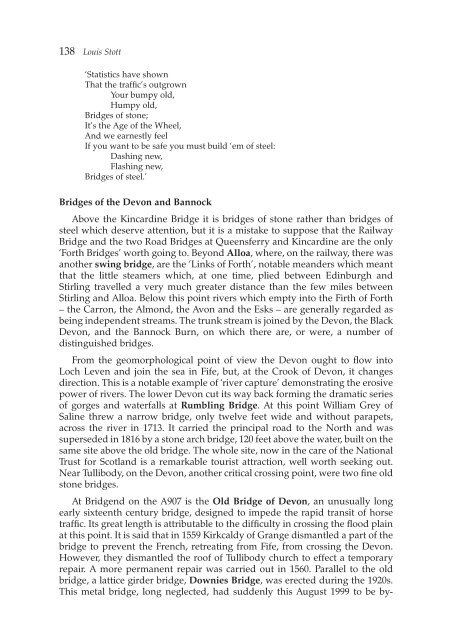the Forth Naturalist Historian - Forth Naturalist and Historian ...
the Forth Naturalist Historian - Forth Naturalist and Historian ...
the Forth Naturalist Historian - Forth Naturalist and Historian ...
Create successful ePaper yourself
Turn your PDF publications into a flip-book with our unique Google optimized e-Paper software.
138 Louis Stott<br />
‘Statistics have shown<br />
That <strong>the</strong> traffic’s outgrown<br />
Your bumpy old,<br />
Humpy old,<br />
Bridges of stone;<br />
It’s <strong>the</strong> Age of <strong>the</strong> Wheel,<br />
And we earnestly feel<br />
If you want to be safe you must build ‘em of steel:<br />
Dashing new,<br />
Flashing new,<br />
Bridges of steel.’<br />
Bridges of <strong>the</strong> Devon <strong>and</strong> Bannock<br />
Above <strong>the</strong> Kincardine Bridge it is bridges of stone ra<strong>the</strong>r than bridges of<br />
steel which deserve attention, but it is a mistake to suppose that <strong>the</strong> Railway<br />
Bridge <strong>and</strong> <strong>the</strong> two Road Bridges at Queensferry <strong>and</strong> Kincardine are <strong>the</strong> only<br />
‘<strong>Forth</strong> Bridges’ worth going to. Beyond Alloa, where, on <strong>the</strong> railway, <strong>the</strong>re was<br />
ano<strong>the</strong>r swing bridge, are <strong>the</strong> ‘Links of <strong>Forth</strong>’, notable me<strong>and</strong>ers which meant<br />
that <strong>the</strong> little steamers which, at one time, plied between Edinburgh <strong>and</strong><br />
Stirling travelled a very much greater distance than <strong>the</strong> few miles between<br />
Stirling <strong>and</strong> Alloa. Below this point rivers which empty into <strong>the</strong> Firth of <strong>Forth</strong><br />
– <strong>the</strong> Carron, <strong>the</strong> Almond, <strong>the</strong> Avon <strong>and</strong> <strong>the</strong> Esks – are generally regarded as<br />
being independent streams. The trunk stream is joined by <strong>the</strong> Devon, <strong>the</strong> Black<br />
Devon, <strong>and</strong> <strong>the</strong> Bannock Burn, on which <strong>the</strong>re are, or were, a number of<br />
distinguished bridges.<br />
From <strong>the</strong> geomorphological point of view <strong>the</strong> Devon ought to flow into<br />
Loch Leven <strong>and</strong> join <strong>the</strong> sea in Fife, but, at <strong>the</strong> Crook of Devon, it changes<br />
direction. This is a notable example of ‘river capture’ demonstrating <strong>the</strong> erosive<br />
power of rivers. The lower Devon cut its way back forming <strong>the</strong> dramatic series<br />
of gorges <strong>and</strong> waterfalls at Rumbling Bridge. At this point William Grey of<br />
Saline threw a narrow bridge, only twelve feet wide <strong>and</strong> without parapets,<br />
across <strong>the</strong> river in 1713. It carried <strong>the</strong> principal road to <strong>the</strong> North <strong>and</strong> was<br />
superseded in 1816 by a stone arch bridge, 120 feet above <strong>the</strong> water, built on <strong>the</strong><br />
same site above <strong>the</strong> old bridge. The whole site, now in <strong>the</strong> care of <strong>the</strong> National<br />
Trust for Scotl<strong>and</strong> is a remarkable tourist attraction, well worth seeking out.<br />
Near Tullibody, on <strong>the</strong> Devon, ano<strong>the</strong>r critical crossing point, were two fine old<br />
stone bridges.<br />
At Bridgend on <strong>the</strong> A907 is <strong>the</strong> Old Bridge of Devon, an unusually long<br />
early sixteenth century bridge, designed to impede <strong>the</strong> rapid transit of horse<br />
traffic. Its great length is attributable to <strong>the</strong> difficulty in crossing <strong>the</strong> flood plain<br />
at this point. It is said that in 1559 Kirkcaldy of Grange dismantled a part of <strong>the</strong><br />
bridge to prevent <strong>the</strong> French, retreating from Fife, from crossing <strong>the</strong> Devon.<br />
However, <strong>the</strong>y dismantled <strong>the</strong> roof of Tullibody church to effect a temporary<br />
repair. A more permanent repair was carried out in 1560. Parallel to <strong>the</strong> old<br />
bridge, a lattice girder bridge, Downies Bridge, was erected during <strong>the</strong> 1920s.<br />
This metal bridge, long neglected, had suddenly this August 1999 to be by-



